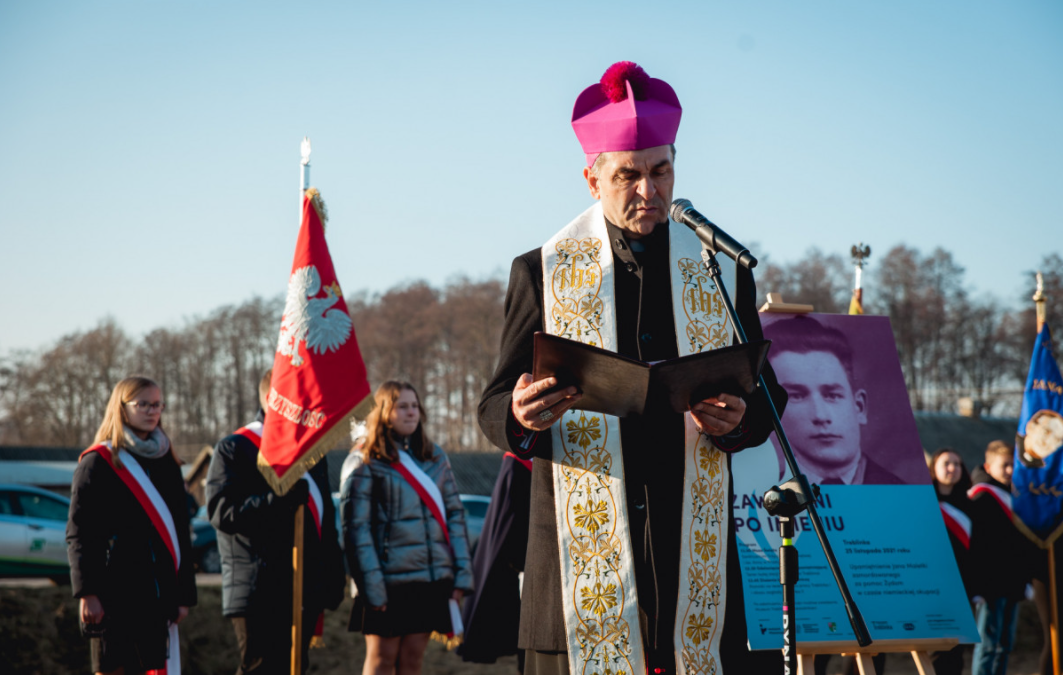A new memorial in the village of Treblinka, honouring a Pole who was killed by the German occupiers for helping Jews being transported to a nearby Nazi death camp, has aroused controversy.
A prominent Holocaust historian has criticised the state-backed memorial, which was unveiled by a deputy minister, arguing that it should not be located alongside what is, after Auschwitz, the “second largest Jewish graveyard in the world”. He says the monument is part of efforts to obscure “Polish complicity in the Holocaust”.
But the deputy minister in question has rejected the claims and accused her academic critics of spreading “hatred” and “fake news”.
Jan Maletka, a railway worker, was killed on 20 August 1942. “He, his brother and a friend saw Jews suffocating in the train, in cattle cars, calling out for water,” said deputy culture minister Magdalena Gawin while unveiling the monument to Maletka on Thursday.
“They [provided help] many times. On this occasion, when Maletka handed over a bucket of water, a German uniformed officer killed him,” she said at the ceremony, which was co-organised by the Pilecki Institute – a historical body set up by the government in 2017 – along with state railways, the Treblinka state museum and local authorities.
Afterwards, participants laid flowers at memorials to Jewish Holocaust victims, murdered Roma and Sinti victims, and forced labourers. “We came here to commemorate the death of 900,000 Jews and of one man [Malekta],” said Gawin, quoted by Dzieje.pl.
Today advertisement screens and platforms at Warsaw’s Central Station will show an animation of the story of Jan Maletka, a railwayman killed in 1942 by the Germans for giving water to a transport of Jews waiting at Treblinka station before entering the death camp. #CalledByName pic.twitter.com/i6USDqe71X
— Instytut Pileckiego (@InstPileckiego) November 25, 2021
After the event, Jan Grabowski, a Polish-born professor of history at the University of Ottawa, took to Facebook to condemn the memorial, which he said was a further attempt by the Pilecki Institute to “distort the history of the Holocaust”.
He argued that Treblinka, where an estimated 900,000 Jews were murdered in gas chambers in the space of just over one year between 1942 and 1943, is “one of the last places of Jewish memory, of Jewish suffering” and should not be presented as a “site of Polish virtue”.
“The appropriation of this space for the reasons of Polish national feel-good narrative is an awful and inexcusable act,” he declared.
In a subsequent article for leading liberal daily Gazeta Wyborcza, published yesterday, Grabowski expanded his criticism. He argued that the memorial was part of efforts by Poland’s national-conservative government to propagate the view that Poles were saviours of Jews during the war.
Ważny artykuł prof. @jgrabows. Sprzeciw wobec upamiętnień polskiego ratowania Żydów w Treblince, Auschwitz czy Bełżcu nie jest skierowany przeciw ratującym. Oni sami z pewnością nie chcieliby widzieć na tych cmentarzyskach pomników wystawionych sobie.https://t.co/DwUot5Bs36
— Michał Bilewicz (@Michal_Bilewicz) November 28, 2021
In actual fact, Grabowski noted, the area around Treblinka was known for “particularly brutal hunting down of Jews…[by] local people, often without any encouragement from the Germans”. Moreover, Poles who offered water to Jews being deported to the death camp often demanded diamonds, gold or other valuables in return.
“I do not know the history of the [particular] Pole commemorated,” wrote Grabowski, who added that Poles who helped Jew should “absolutely” be honoured.
“But that is not what it is all about here,” he continued. “The Pilecki [Institute]’s goal is not to commemorate individually, but to blitz through the areas where Polish complicity in the crime of the Holocaust is particularly visible and extremely painful.”
Separately, the current chairman of B’nai B’rith in Poland, Andrzej Friedman, and his predecessor, Sergiusz Kowalski, penned an open letter condemning the “disgusting” memorial. “Before Poland starts erecting monuments to Poles in Jewish cemeteries, it must remember about the Jews murdered with the participation of Poles,” they wrote.
Following Grabowski’s criticism, Gawin reacted quickly on Twitter, accusing the historian of promulgating “hatred”. She also said that he and other critics were spreading “fake news”.
Another academic – Michał Bilewicz, head of the University of Warsaw’s Centre for Research on Prejudice – accused Gawin of “sophisticated trolling” and argued that the memorial could have been erected elsewhere.
Gawin responded by noting that it was placed at the site of Maletka’s death. She also pointed out that, while it is in the village of Treblinka, it is not within the boundaries of the former death camp.
Chłopak zginał we wsi Treblinka,Wieś to nie obóz śmierci. Do czego doszło, ze obraza Pana pamięć o człowieku, który nie opuścił Żydów w najczarniejszych dniach i zapłacił za to życiem.
— Magdalena Gawin (@MagdalenaGawin1) November 25, 2021
Since 2019, the Pilecki Institute has erected over 20 memorials to Poles killed by the German occupiers for helping Jews during the Holocaust. The programme is part of broader efforts by the Polish authorities to commemorate and draw attention to such actions.
They argue that the role of Poles in helping Jews during the war has for too long been ignored – or even deliberately suppressed and distorted. Critics, however, accuse the government of itself distorting history by focusing exclusively on heroic actions while ignoring crimes committed by Poles against Jews.
Grabowski himself has been among the foremost critics. Earlier this year, he faced trial in Poland over claims in a book he edited that a Polish village mayor had been involved in the deaths of Jews during the war. While an initial ruling ordered Grabowski to apologise, that was later overturned on appeal.
Main image credit: Pat Mic/Instytut Pileckiego

Daniel Tilles is editor-in-chief of Notes from Poland. He has written on Polish affairs for a wide range of publications, including Foreign Policy, POLITICO Europe, EUobserver and Dziennik Gazeta Prawna.




















